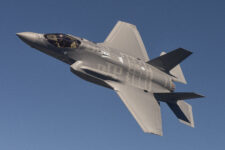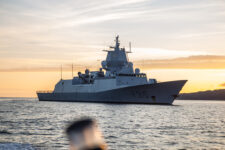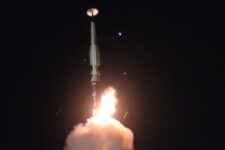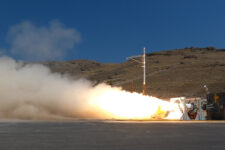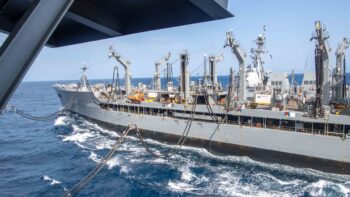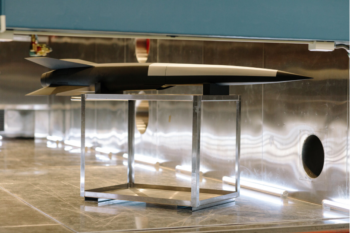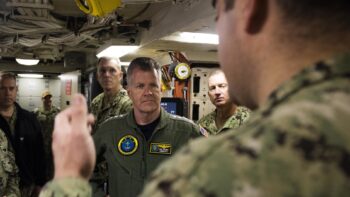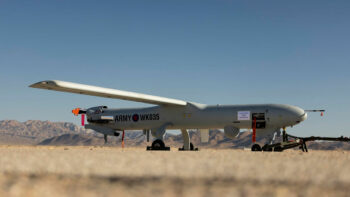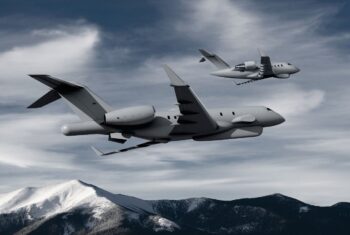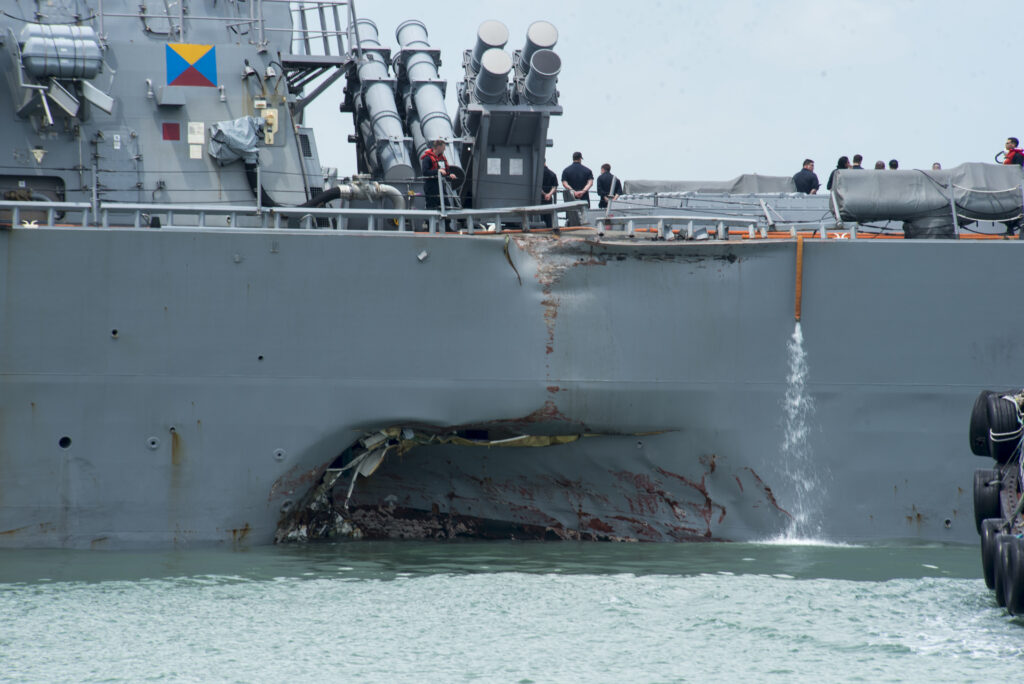
The USS McCain heads for Shanghai after a collision that killed 10 sailors.
CAPITOL HILL: Congress’s repeated budget malpractice and the Navy’s flawed policies combined to cause the accidents that killed 17 sailors, the Navy and the GAO say. Legislative dysfunction means budget cuts, caps, and delays have chronically shortchanged training and maintenance across the fleet, forcing sailors to work 100-plus hours a week to try to catch up. But the Navy also made fundamentally flawed assumptions about its Japan-based ships, overworking them even more at the expense of safety – even as it kept assigning more ships to what it considered an exemplary unit.
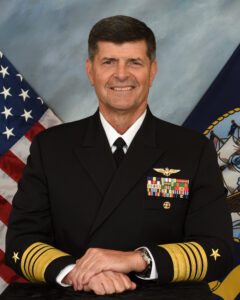
Adm. William Moran, Vice Chief of Naval Operations
“I personally have made the assumption for many, many years that our forward-deployed force in Japan was the most proficient, well-trained, most experienced force we have, because they’re operating all the time,” Adm. Bill Moran, vice-Chief of Naval Operations, told the House Armed Services seapower subcommitte yesterday. “It was the wrong assumption.”
In fact, the assumption was exactly backwards. To keep “operating all the time,” the Japan-based ships were cutting corners. This showed up in their proficiency certifications, normally awarded to the crew for demonstrating the requisite skill levels in various areas from basic safety to ballistic missile defense. In January 2015, GAO found, destroyers and cruisers based in Japan had 93 percent of their required certifications, with only 7 percent expired. In June 2017, 37 percent of certifications had expired.
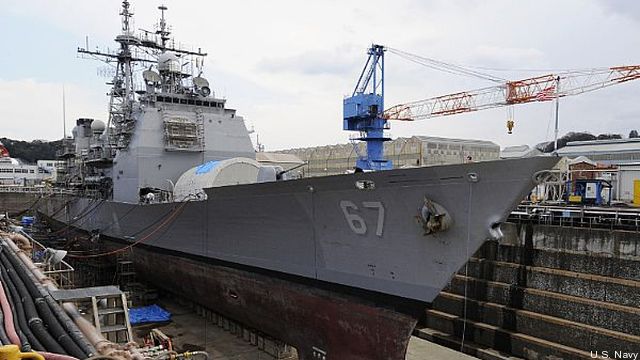
The Ticonderoga-class cruiser Shiloh in dry dock in Yokosuka, Japan.
Sleepless In Tokyo
Japan-based ships were missing training simply because they had much less time to train. The Navy’s US-based ships operate on a 36-month cycle: 6.5 months tied up for major maintenance, 9.5 months for pre-deployment training in US waters, 7 months deployed, and a 13-month “sustainment” period when the ship is on call for further deployments. In practice, deployments often go long, putting more wear on ships, which means they need more time in maintenance, which means they don’t deploy on time and other ships have to stay at sea longer to compensate, a vicious cycle. But at least regular training is enshrined in the schedule.
By contrast, ships based in Japan and other foreign ports, the Forward-Deployed Naval Forces (FDNF), are on a 24-month cycle: eight months maintenance, 16 months deployed. So when do they train? In theory, being deployed 67 percent of the time – as opposed to 19 percent for US-based ships – keeps the foreign-based ships sharp. In practice, they’re busy doing missions for Pacific Command and can’t fit in all the training required to get certified in critical skills.
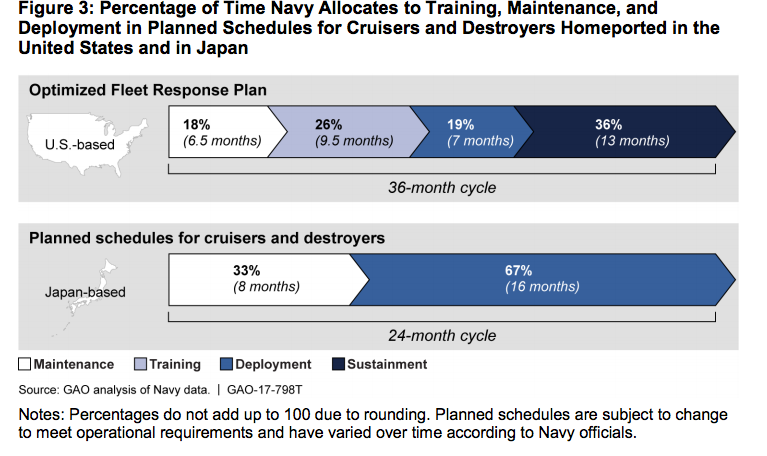
Source: GAO
“We were told that the overseas-based ships were so busy that they had to ‘train on the margins,’ a term I’d not heard before,” GAO’s John Pendleton testified. “It was explained to me that meant they had to squeeze training in when we could.” While the Navy promised GAO it would put dedicated training time in the schedule, he added, that hasn’t happened.
What’s more, GAO found, the FDNF maintenance plan omitted some in-depth maintenance on the assumption they’d make it up when they were reassigned to US homeports after seven to ten years in Japan. But the Yokosuka-based destroyer USS Fitzgerald, which lost seven sailors in a collision with a civilian vessel, had been in Japan for “well over 10 years,” fumed House seapower chairman Rob Wittman. The destroyer McCain, which lost 10 sailors after hitting an oil tanker, had been there “for over 20 years.”
Older ships are harder to maintain because their equipment has had more time to wear out. Older ships that defer major maintenance for a decade or two are begging for trouble.
Yet despite these systematic problems, each ship based overseas was spending more days at sea and on mission than ships based in the US. That was the metric that mattered in a Navy hard-pressed to meet historically high operational demands with an historically low number of ships. As a result, since 2013, the Navy has doubled the number of ships deployed abroad, going from 20 ships to 40 in Japan, Spain, Bahrain, and Italy. An additional destroyer was coming to Yokosuka next year, but Moran said that plan’s on pause.
“This increasing reliance on Forward Deployed Naval Forces is a model that is not sustainable,” said Wittman.
Congress, of course, has a parochial interest in keeping ships based in the US, where their maintenance spending and crew salaries shore up local economies. And it’s a geostrategic mistake to write off forward-deployed forces. Even if their schedules were recalibrated to something more sustainable, with fewer days deployed, they would still have the advantage of being based closer to potential trouble spots. US ships that can be on the scene in hours or days deter adversaries and reassure allies more strongly than ships that will take weeks to get there.
“Those ships are a lot closer to where we might have to fight,” said Moran.
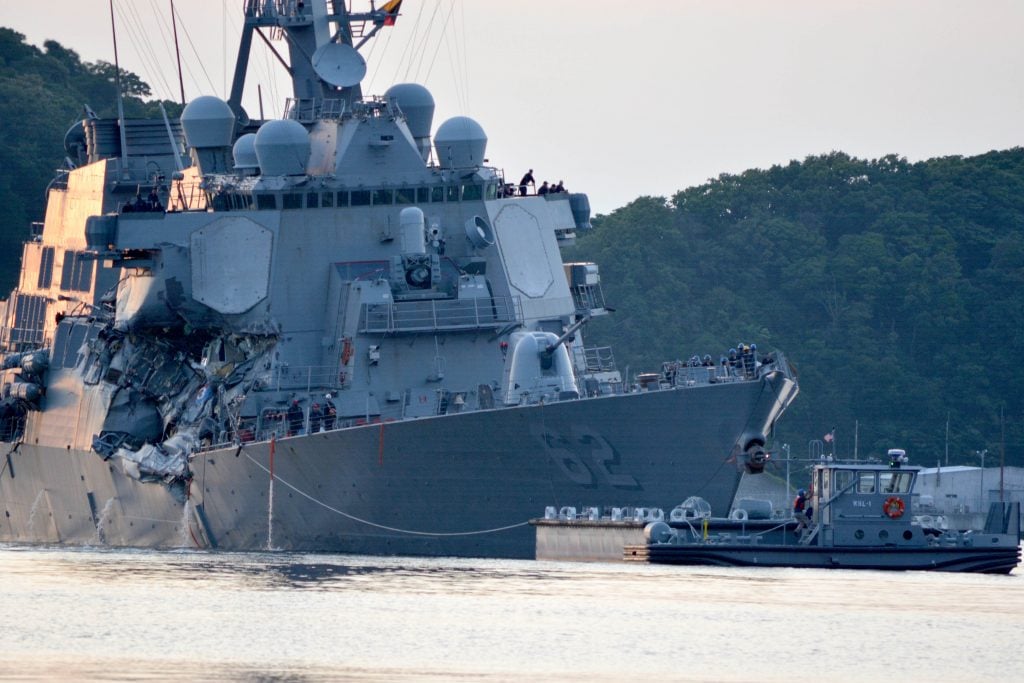
The damaged destroyer USS Fitzgerald pulls into Yokosuka, Japan after colliding with a commercial ship. Seven sailors died.
A Navy Under Stress
Finally, while the overworked Japan-based fleet may be the canary in the coal mine, the underlying problems are Navy-wide. A 2014 study found sleep-deprived sailors were on duty 108 hours a week (that’s 15.4 hours a day, seven days a week). As for the equipment, GAO found that significant breakdowns (casualty reports) “nearly doubled” from 2009 through 2014. As a result, of the 169 ships that went into major maintenance during 2011-2016, almost two-thirds (63 percent) required more work and took longer than expected, costing the Navy 6,603 ship-days at sea.
What is the Navy doing to fix things? The root of the problem is decades old and will take decades to undo. Ships built during the 1980s Reagan buildup are starting to go out of service, and not enough ships were built in the 1990s “peace dividend” period, so the fleet has shrunk. From a peak of 594 ships in 1987, the Navy is down to 277 ships today and says it needs to grow to 355 – but that’ll take until at least 2032. Yet the Navy’s workload has stayed about the same, with roughly 100 ships deployed overseas at any given time.
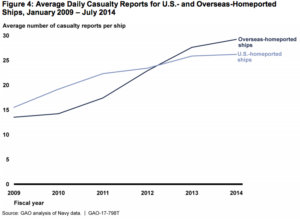
Navy equipment breakdowns have “nearly doubled” in recent years, according to the GAO
A smaller fleet doing more work needs steady, generous funding for training and maintenance to get the most out of every ship and crew, but the Navy hasn’t had that. Instead, the 2011 Budget Control Act led to the 2013 sequester – whose automatic cuts fell most heavily on relatively fungible readiness funds rather than procurement or personnel – and to caps on defense spending every year thereafter. Congress has repeatedly tweaked the caps upward, but it’s also been unable to pass a budget on time for almost a decade, leaving the government funded by stopgap Continuing Resolutions that hamstring operations for months at a time.
The Budget Control Act has “absolutely” undermined readiness, Moran said, “that and nine consecutive Continuing Resolutions.”
“We do have a plan (for) buying down the maintenance backlogs, getting our manpower in the right place,” Moran said, “(but) we must have some stability in the budget so we can follow through on those plans.”
Even with stable funding, it will take years to improve readiness and reduce the chances for more collisions and more breakdowns. In the nearer term, the only lever available to ease the stress on the Navy is to ask it to do less. That has already happened in a limited way with the multi-month gaps when we had no aircraft carrier stationed in the Persian Gulf, which Moran called “painful.” But global demand remains high.
“When do you and Adm. Richardson basically say to the Secretary of Defense or the president, ‘we cannot do what you expect us to do?'” asked Rep. Mac Thornberry, chairman of the House Armed Services Committee.
“They’re going to have to prioritize and say, ‘well maybe some of the things we try to do by spreading ourselves so thin, maybe we can’t do those things, or maybe we change how we do those things,'” Rep. Rob Wittman, chairman of the seapower subcommittee, told reporters after the hearing.
The problem, though, is that the Navy has to keep pace with a growing North Korean missile threat, with an increasingly assertive Russian navy in the Mediterranean and the Caribbean, and with Chinese expansion in the South China Sea, added Rep. Joe Wilson, readiness chairman, who co-chaired the hearing with Wittman.
“It’s not (just) the demand signal coming from the combatant commanders,” agreed Wittman. “It’s the world.”
Romania signs LOA to secure entry to F-35 club
“This decision marks a significant milestone in Romania’s defense strategy and its commitment to maintaining a robust and advanced military force,” Lockheed Martin said in a statement.
